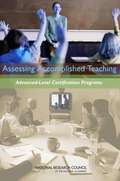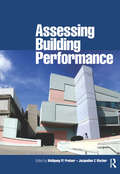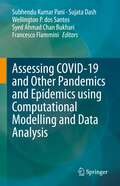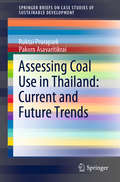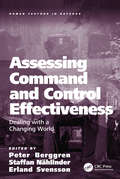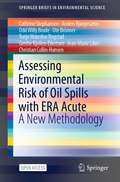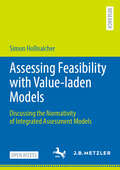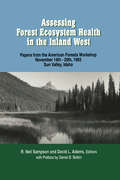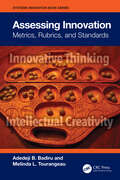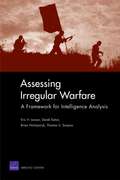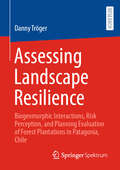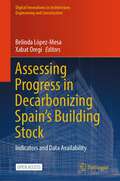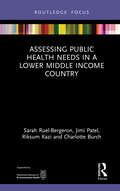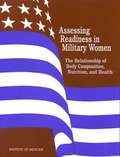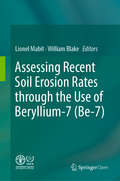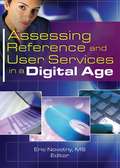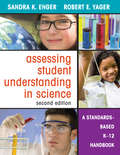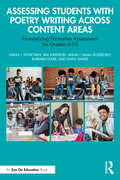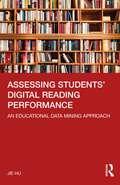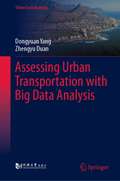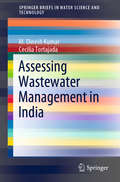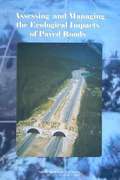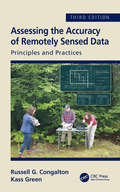- Table View
- List View
Assessing Accomplished Teaching: Advanced-Level Certification Programs
by National Research Council of the National AcademiesThe mission of the National Board for Professional Teaching Standards (NBPTS) is to establish “high and rigorous standards for what teachers should know and be able to do, to certify teachers who meet those standards, and to advance other education reforms for the purpose of improving student learning in American schools.” In response to a request from the U.S. Congress, the National Research Council developed a framework for evaluating programs that award advanced-level teacher certification and applied that framework in an evaluation of the impacts of the NBPTS. Specifically, this book addresses the impacts on students, teachers, and the educational system in this country. Assessing Accomplished Teaching finds that teachers who earn board certification are more effective at improving their students’ achievement than other teachers, but school systems vary greatly in the extent to which they recognize and make use of board-certified teachers. Many of the questions on the evaluation framework could not be answered because the data have not been collected, and the report makes recommendations for the kinds of research that are needed to fully evaluate the impacts of board certification by the NBPTS.
Assessing Bacterial Growth Potential in Seawater Reverse Osmosis Pretreatment: Method Development and Applications (IHE Delft PhD Thesis Series)
by Almotasembellah AbushabanSeawater desalination is increasingly being used as a means to augment freshwater supplies in regions with high water stress, and reverse osmosis is increasingly the technology of choice because of the low energy consumption. However, seawater reverse osmosis (SWRO) systems suffer from various types of fouling, which can increase energy consumption and the use of chemicals during SWRO operation. In practice, pre-treatment systems are put in place to reduce the particulate and biological fouling potential of SWRO feed water. However, simple, reliable and accurate methods to assess the extent to which biological fouling potential is reduced during pre-treatment are not available for seawater. This research developed a new method to measure bacterial growth potential (BGP) using the native bacterial consortium in seawater. New reagents to extract and detect ATP in microbial cells were specifically developed for seawater. The new lysis and detection reagents overcame the salt interference in seawater and allow low detection of total ATP, free ATP and microbial ATP in seawater. Incorporating a filtration step further increased the sensitivity of the method six fold, enabling ATP detection of ultra-low levels of microbial ATP in seawater. The newly developed ATP-based BGP method was applied to monitor and assess the pre-treatment of five full-scale seawater desalination plants around the world. A good correlation was observed between BGP measured in SWRO feed water and the pressure drop increase in the SWRO systems, suggesting the applicability of using the ATP-based BGP method as a biofouling indicator in SWRO. Furthermore, a safe level of BGP ( In the future, on-line monitoring of BGP in SWRO feed water may further reduce the consumption of chemicals and energy and improve the overall sustainability of seawater desalination by reverse osmosis.
Assessing Building Performance
by Wolfgang F.E. Preiser Jacqueline C. VischerThe building performance evaluation (BPE) framework emphasizes an evaluative stance throughout the six phases of the building delivery and life cycle: (1) strategic planning/needs analysis; (2) program review; (3) design review; (4) post-construction evaluation/review; (5) post-occupancy evaluation; and, (6) facilities management review/adaptive reuse.The lessons learned from positive and negative building performance are fed into future building delivery cycles. The case studies illustrate how this basic methodology has been adapted to a range of cultural contexts, and indicates the positive results of building performance assessment in a wide range of situations.
Assessing COVID-19 and Other Pandemics and Epidemics using Computational Modelling and Data Analysis
by Francesco Flammini Sujata Dash Subhendu Kumar Pani Wellington P. dos Santos Syed Ahmad Chan BukhariThis book comprehensively covers the topic of COVID-19 and other pandemics and epidemics data analytics using computational modelling. Biomedical and Health Informatics is an emerging field of research at the intersection of information science, computer science, and health care. The new era of pandemics and epidemics bring tremendous opportunities and challenges due to the plentiful and easily available medical data allowing for further analysis. The aim of pandemics and epidemics research is to ensure high-quality, efficient healthcare, better treatment and quality of life by efficiently analyzing the abundant medical, and healthcare data including patient’s data, electronic health records (EHRs) and lifestyle. In the past, it was a common requirement to have domain experts for developing models for biomedical or healthcare. However, recent advances in representation learning algorithms allow us to automatically learn the pattern and representation of the given data for the development of such models. Medical Image Mining, a novel research area (due to its large amount of medical images) are increasingly generated and stored digitally. These images are mainly in the form of: computed tomography (CT), X-ray, nuclear medicine imaging (PET, SPECT), magnetic resonance imaging (MRI) and ultrasound. Patients’ biomedical images can be digitized using data mining techniques and may help in answering several important and critical questions related to health care. Image mining in medicine can help to uncover new relationships between data and reveal new and useful information that can be helpful for scientists and biomedical practitioners. Assessing COVID-19 and Other Pandemics and Epidemics using Computational Modelling and Data Analysis will play a vital role in improving human life in response to pandemics and epidemics. The state-of-the-art approaches for data mining-based medical and health related applications will be of great value to researchers and practitioners working in biomedical, health informatics, and artificial intelligence..
Assessing Coal Use in Thailand: Current and Future Trends (SpringerBriefs on Case Studies of Sustainable Development)
by Ruktai Prurapark Pakorn AsavaritikraiThis book highlights Thailand’s growing demand for clean energy from coal. The main source of energy for electricity production in Thailand (70%) is currently natural gas. However, natural gas extraction remains limited, resulting in an increasing need to import natural gas from other countries, which in turn leads to rising prices and unstable supplies. As such, coal energy is essential for industrial use and electricity production in Thailand. The book discusses the importance of developing and implementing clean technologies for coal. It also argues that collaborations between the government, private sector and the public are vital to achieving a mutual understanding and acceptance of coal energy and clean technologies, as well as a reduction in harmful emissions.
Assessing Command and Control Effectiveness: Dealing with a Changing World (Human Factors in Defence)
by Peter Berggren Staffan Nählinder Erland SvenssonAssessing Command and Control Effectiveness: Dealing with a Changing World offers a description of the current state of Command and Control (C2) research in imperfect settings, showing how a research process should assess, analyse and communicate results to the development cycle of methods, work, manning and C2-technology. Special attention is given to the development of C2 research methods to meet the current and coming needs. The authors also look forward towards a future where effective assessment of C2 abilities are even more crucial, for instance in agile organisations. The purpose of the C2 research is to improve the process and make it more effective while still saving time and money. Research methods have to be chosen carefully to be effective and simple, yet provide results of high quality. The methodological concerns are a major consideration when working under such circumstances. Furthermore, there is often a need for a swift iterative development cycle, and thus a demand to quickly deliver results from the research process. This book explains how field research experimentation can be quick, simple and effective, being able to draw valid conclusions even when sample sizes are small and resources are limited, collecting empirical data using measures and procedures that are minimally intrusive.
Assessing Environmental Risk of Oil Spills with ERA Acute: A New Methodology (SpringerBriefs in Environmental Science)
by Cathrine Stephansen Anders Bjørgesæter Odd Willy Brude Ute Brönner Tonje Waterloo Rogstad Grethe Kjeilen-Eilertsen Jean-Marie Libre Christian Collin-HansenThis open access book introduces readers to a new methodology for assessing the risks to the marine environment following accidental oil spills. The methodology will soon be implemented on the Norwegian Continental Shelf and will be complemented by guidelines for its use in a regulatory framework. The brief book is intended to provide international readers with a basic grasp of what the ERA Acute methodology consists of, what its applications are, and the underlying impact and restoration models used in its development. The content is divided into three main parts: an introduction and overview of risk management applications for generalists at the management level, a model overview for generalist scientists, and a more detailed final section for risk assessment professionals, which presents the results of the validation and sensitivity testing.
Assessing Feasibility with Value-laden Models: Discussing the Normativity of Integrated Assessment Models
by Simon HollnaicherIn this Open-Access-book, the author investigates the value dimension of Integrated Assessment Models and their application to questions of feasibility. Integrated models provide a quantified representation of the interaction between the socio-economic system with the climate and serve as a pivotal tool at the intersection of climate science, policymakers, and society. This book critically examines how IAMs approach the concept of feasibility. It unpacks the value assumptions embedded within integrated modeling, critiques the implicit normativity of these models, and proposes principles for responsibly managing value judgments in scientific advice. Arguing for a thick conception of feasibility—one that integrates key normative dimensions—it highlights the gap between conceptual discussions of feasibility and the scientific practices that inform feasibility assessments. Addressed to both philosophers and integrated modelers, this book sheds light on the implicit values shaping our collective visions for the future.
Assessing Forest Ecosystem Health in the Inland West
by David L. AdamsInland West, their historical origins, assessments of available management tools, and analyses of the various choices available to policymakers. Its goal is to help people understand the Inland West forests so that public policies can reflect a constructive and realistic framework in which forests can be managed for sustained health. This resource is the product of a scientific workshop where 35 participants, including scientists, resource managers, administrators, and environmentalists, addressed the forest health problem in the Inland West. Synthesis chapters integrate the diverse knowledge and experience which participants brought to the workshop. They identify and link together many of the ecological, social, and administrative conditions which have created the forest health problem in the West. The book is unique in that it reflects a process that fostered the use of academic research, field realities, and industrial knowledge to define an interdisciplinary problem, establish rational policy objectives, and set-up “do-able” management approaches.The following topics are analyzed: Assessing forest ecosystem health in the Inland West Historical and anticipated changes in forest ecosystems in the Inland West Defining and measuring forest health Historical range of variability as a tool for evaluating ecosystem change Administrative barriers to implementing forest health problems Economic and social dimensions of the forest health problem Fire management Ecosystem and landscape management
Assessing Innovation: Metrics, Rubrics, and Standards (Systems Innovation Book Series)
by Adedeji B. Badiru Melinda TourangeauWe cannot manage and control what we cannot measure and assess. Poor assessment results have been cited as a primary reason for project failures, in terms of cost, schedule, and quality. This book introduces metrics, rubrics, and standards pertinent to assessing innovation.Assessing Innovation: Metrics, Rubrics, and Standards provides a new view for the embracing of innovation and establishing a quantitative basis for determining innovation levels. It bridges innovation with practice and presents a systems view as it incorporates the human element and discusses the different roles carried out. This book offers standards that will guide readers as they tackle sustaining innovation and leverages Badiru’s Umbrella Model in the process.The inclusion of methodologies suitable for determining where and when innovation is happening, and to what extent it is currently being carried out, make this a unique book, along with being the only book that addresses innovation metrics, rubrics, and standards in an integrated fashion. Seen as a way to help advance the diverse pursuit of innovation, this book is an ideal read for those in engineering, business, industry, academia, government, and the military.
Assessing Irregular Warfare
by Eric V. Larson Brian Nichiporuk Derek Eaton Thomas S. SzaynaProvides an analytic framework and procedure for the intelligence analysis of irregular warfare (IW) environments that can serve as the basis for IW intelligence curriculum development efforts. Defines IW in terms of two stylized situations: population-centric (such as counterinsurgency) and counterterrorism. Provides a detailed review of IW-relevant defense policy and strategy documents and a list of relevant doctrinal publications.
Assessing Landscape Resilience: Biogeomorphic Interactions, Risk Perception, and Planning Evaluation of Forest Plantations in Patagonia, Chile
by Danny TrögerThis book examines the extent to which exotic pine plantations are a suitable strategy for maintaining the essential functions, structures, processes and identity of the Patagonian landscape over time. To this end, it integrates three empirical studies with inter- and transdisciplinary approaches under the theoretical framework of landscape resilience. The first study analyses the biogeomorphic interactions of different land uses and their relevance for soil conservation and landslide mitigation. The second study examines perceptions of natural hazards and focuses on networks of human and non-human actors that maintain landscape resilience. The results of these two studies are incorporated into the planning evaluation of land zoning and alternative strategies are developed, inspired by normative polycentric governance. It is concluded that Pinus plantations partially fulfil their ecological objectives of erosion control and landslide mitigation. However, their performance lags behind that of secondary forests with native species and they create new risks such as reduced biodiversity, increased risk of wildfires and conflicts with local identity. The book concludes with new research questions of trans-regional importance.
Assessing Progress in Decarbonizing Spain’s Building Stock: Indicators and Data Availability (Digital Innovations in Architecture, Engineering and Construction)
by Belinda López-Mesa Xabat OregiThis open access book delves into the topic of monitoring the effectiveness of building renovation policies within the European Union (EU) using indicators. Given the substantial environmental impact of existing buildings on energy consumption and greenhouse gas emissions, decarbonizing them is imperative for achieving climate neutrality in Europe. The use of indicators for monitoring decarbonization progress and evaluating policies emerges as a valuable tool, ensuring the efficiency, effectiveness, and alignment of building renovation policies with broader sustainability and climate objectives. Additionally, this approach facilitates evidence-based decision-making, promotes accountability by Member States (MSs), supports the realization of long-term goals, and actively involves the public in these vital initiatives. The European Commission is actively engaged in this realm, releasing a framework of optional indicators in 2019 and subsequently refining it during the review of the Energy Performance of Buildings Directive. The evolving framework seeks to encompass both mandatory and optional indicators, posing greater challenges for EU MSs in monitoring the impact of their national building renovation policies and the progress of decarbonizing their building stocks. This book offers insights into these developing indicator frameworks, assesses the availability and quality of data in the case of Spain, and suggests areas of improvement and innovative approaches using emerging technologies to enhance data. The target audience includes diverse stakeholders such as central government administrations, regional and municipal authorities, data-collecting institutions, urban planners, researchers, and citizens interested in comprehending the impact of building renovation. By addressing this broad audience, the book aims to foster a more inclusive and well-informed discussion on building renovation and the decarbonization of the European building stock.
Assessing Public Health Needs in a Lower Middle Income Country (Routledge Focus on Environmental Health)
by Sarah Ruel-Bergeron Jimi Patel Riksum Kazi Charlotte BurchThis book demonstrates a methodology for assessing public health needs in communities experiencing environmental sanitation inadequacies. Centring on a case study of the Republic of Cameroon, the findings represent the starting point of a campaign to implement a comprehensive water and sanitation infrastructure through advocacy, housing improvements, and new service chains. Based on an assessment report undertaken by ARCHIVE Global, an international non-profit organization focusing on the link between health and housing, this book: Explores and establishes a causal relationship between the built environment and its impacts on public health Uses the United Nations’ Sustainable Development Goals as a benchmark for highlighting issues and challenges with sanitation infrastructure projects Provides lessons for communities around the world facing environmental health issues similar to those Cameroon’s Idenau Municipality deals with. This book is intended for environmental health professionals, academics and policymakers, be they domestic to the African region or multinational practitioners. Donor countries, the likes of the United States and European nations, will also value the book’s advocacy for interventions in the built environment and current public health impacts.
Assessing Readiness in Military Women: The Relationship of Body Composition, Nutrition, and Health
by Committee on Body Composition Nutrition Health of Military WomenU.S. military personnel are required to adhere to standards of body composition, fitness, and appearance to achieve and maintain readiness--that is, the maintenance of optimum health and performance so they are ready for deployment at any moment. In 1992, the Committee on Military Nutrition Research reviewed the existing standards and found, among other things, that the standards for body composition required for women to achieve an appearance goal seemed to conflict with those necessary to ensure the ability to perform many types of military tasks. This report addresses that conflict, and reviews and makes recommendations about current policies governing body composition and fitness, as well as postpartum return-to-duty standards, Military Recommended Dietary Allowances, and physical activity and nutritional practices of military women to determine their individual and collective impact on the health, fitness, and readiness of active-duty women.
Assessing Recent Soil Erosion Rates through the Use of Beryllium-7 (Be-7)
by William Blake Lionel MabitThis open access book is the first comprehensive guideline for the beryllium-7 (Be-7) technique that can be applied to evaluate short-term patterns and budgets of soil redistribution in agricultural landscapes. While covering the fundamental and basic concepts of the approach, this book distinguishes itself from other publications by offering step-by-step instructions on how to use this isotopic technique effectively. It covers experimental design considerations and clear instruction is given on data processing. As accurate laboratory measurement is crucial to ensure successful use of Be-7 to investigate soil erosion, a full chapter is devoted to its specific determination by gamma spectrometry. This open access contribution further describes new developments in the Be-7 technique and includes a concluding chapter highlighting its potential benefits to support the implementation of area-wide soil conservation policy.
Assessing Reference and User Services in a Digital Age
by Eric NovotnyEffectively assess whether any library is making good use of the reference/user service resources available todayLibraries need to develop standards by which they can assess their individual performances in a larger context, and Assessing Reference and User Services in a Digital Age makes significant contributions to this ongoing discussion. The book addresses its subject matter via approaches ranging from case studies of individual libraries to general discussions of best practices. The contributors explore the impact of the Internet on the field of evaluation, focusing on electronic reference and instruction. They highlight current issues, present research results, and offer expert advice on how to assess online reference and instruction. All chapters are well referenced to facilitate further study, and many include tables, appendixes, checklists, and other helpful features that make difficult information easy to access and understand.The chapters that make up Assessing Reference and User Services in a Digital Age are as rich and varied as the backgrounds of their authors. Experienced researchers provide the results of studies conducted to determine the nature and effectiveness of the online reference services offered by various libraries. Practitioners and administrators from different institutional settings (academic libraries, public libraries, consortiums, etc.) provide their perspectives on the issues facing librarians who need to assess the electronic services they provide.In this important new book: Andrew Briedenbagh shows how a chat service can be implemented and suggests which data should be collected for it Buff Hirko examines VET: the Virtual Evaluation Toolkit Ruth Vondracek shares the experiences of a university library as it entered a statewide e-reference consortium, and offers advice and issues to consider before entering such a partnership librarians from San Jose State University present a model for evaluating electronic reference services that can be used in public or academic libraries Kathleen Kern discusses holistic evaluation chat transcripts are addressed in several chapters, including Joseph Fennewald&’s comparisons of question categories, Lesley Moyo&’s analysis of the use of instruction in the virtual environment, and Caleb Tucker-Raymond&’s proposed set of quality measures for chat reference Laurie Probst and Michael Pelikan report on the use of a "Tell Us What You Think" button to gather user feedback Kristi Nelson and Catherine L. Ross examine a research study that asked library school students to submit a reference question online and report on their experiences Melissa Gross, Charles McClure, and R. David Lankes suggest measures to determine the cost and benefits of a virtual reference service librarians from Utah State University describe the development of their online instructional moduleAssessing Reference and User Services in a Digital Age is designed as essential reading for library administrators, public service librarians, and researchers. It provides general advice for practitioners as well as an examination of research results and methodological issues. We urge you to consider making it part of your professional or teaching collection today.
Assessing Student Understanding in Science: A Standards-Based K-12 Handbook
by Dr Robert E. Yager Sandra K. EngerProvides extensive standards-based examples for assessing science teaching and learning, including the use of portfolios, formative assessments, student self-evaluations, rubrics, and science notebooks.
Assessing Students with Poetry Writing Across Content Areas: Humanizing Formative Assessment for Grades 6-12
by Kim Johnson Sarah J. Donovan Anna J. Roseboro Barbara Edler Gayle SandsAssessing Students with Poetry Writing Across Content Areas reimagines formative assessment by advocating for a dynamic, poetic approach that delves into students’ meaning-making processes. It is a guide for teachers seeking innovative approaches to formative assessment, promoting a holistic, creative, reflective, and collaborative learning environment. It challenges the limitations of traditional worksheets and quizzes, urging educators to move beyond seeking restrictive answers and embrace students’ texts as pathways to understanding.The authors put forward poetry as a vigorous tool and writing poetry as an act to foster deep learning across content areas. Practical examples of acrostic poems, haiku, and pantoum demonstrate the adaptability of poetic forms to diverse subjects. Through adaptable lesson plans that can be used across history, math, world languages, ELA, and science, the book encourages intentional poetic writing-to-learn activities and explores how poetry might present itself as a short, creative assessment tool that helps teachers see what their students know and can do while also offering them the space to make new meaning in their original poetry.This book is a key resource for in-service educators teaching grades 6-12.
Assessing Students' Digital Reading Performance: An Educational Data Mining Approach
by Jie HUThis book provides a systematic study of the Programme for International Student Assessment (PISA) based on big data analysis, aiming to examine the contextual factors relevant to students’ digital reading performance. The author first introduces the research landscape of educational data mining (EDM) and reviews the PISA framework since its launch and how it has become an important metric to assess the knowledge and skills of students from across the globe. With a focus on methodology and its applications, the book explores extant scholarship on the dynamic model of educational effectiveness, multi-level factors of digital reading performance, and the application of EDM approaches. The core chapter on the methodology examines machine learning algorithms, hierarchical linear modeling, mediation analysis, and data extraction and processing for the PISA dataset. The findings give insights into the influencing factors of students’ digital reading performance, allowing for further investigations on improving students’ digital reading literacy and more attention to the advancement of education effectiveness. The book will appeal to scholars, professionals, and policymakers interested in reading education, educational data mining, educational technology, and PISA, as well as students learning how to utilize machine learning algorithms in examining the mass global database.
Assessing Urban Transportation with Big Data Analysis (Urban Sustainability)
by Dongyuan Yang Zhengyu DuanThis book chiefly focuses on urban traffic, an area supported by massive amounts of data. The application of big data to urban traffic provides strategic and technical methods for the multi-directional and in-depth observation of complex adaptive systems, thus transforming conventional urban traffic planning and management methods. Sharing valuable insights into how big data can be applied to urban traffic, it offers a valuable asset for information technicians, traffic engineers and traffic data analysts alike.
Assessing Wastewater Management in India (SpringerBriefs in Water Science and Technology)
by M. Dinesh Kumar Cecilia TortajadaThis book highlights the institutional, legal, and policy measures to manage water pollution in India, and discusses how effective they have been in improving the overall quality of the country’s surface and groundwater resources. It also reviews the status of wastewater generation, collection and treatment in urban areas to provide insights into the gaps in wastewater treatment. Further, it offers a detailed analysis of the wastewater treatment systems available and examines the human health impacts of water pollution in the country, as well as the future trajectory of investment in wastewater treatment systems and potential sectors for reuse and recycling of wastewater, briefly assessing the market demand for treated wastewater. Lastly, it investigates the factors influencing the environmental sustainability and economic viability of wastewater treatment as well as future areas of research in the field.
Assessing and Managing the Ecological Impacts of Paved Roads
by National Research Council of the National AcademiesAll phases of road development—from construction and use by vehicles to maintenance—affect physical and chemical soil conditions, water flow, and air and water quality, as well as plants and animals. Roads and traffic can alter wildlife habitat, cause vehicle-related mortality, impede animal migration, and disperse nonnative pest species of plants and animals. Integrating environmental considerations into all phases of transportation is an important, evolving process. The increasing awareness of environmental issues has made road development more complex and controversial. Over the past two decades, the Federal Highway Administration and state transportation agencies have increasingly recognized the importance of the effects of transportation on the natural environment. This report provides guidance on ways to reconcile the different goals of road development and environmental conservation. It identifies the ecological effects of roads that can be evaluated in the planning, design, construction, and maintenance of roads and offers several recommendations to help better understand and manage ecological impacts of paved roads.
Assessing the Accuracy of Remotely Sensed Data: Principles and Practices, Third Edition (Mapping Science Ser.)
by Russell G. Congalton Kass GreenThe past 10 years have brought amazing changes to the technologies used to turn remotely sensed data into maps. As a result, the principles and practices necessary for assessing the accuracy of those maps have also evolved and matured. This third edition of Assessing the Accuracy of Remotely Sensed Data: Principles and Practices is thoroughly updated and includes five new chapters. Now 15 chapters long, this text is the only one of its kind to provide geospatial analysts with the requisite considerations, tools, and theory necessary to conduct successful and efficient map accuracy assessments; and map users with the knowledge to fully understand the assessment process to ensure effective use of maps. See What’s New in the Third Edition: All original chapters have been updated to include new standards, practices, and methodologies. A new chapter on planning accuracy assessments. A new chapter on assessing maps created using object-based technologies. Two case study chapters - one showcasing the assessment of maps created from traditional methods, and one on the assessment of object-based maps. Emphasis on considering and planning for positional accuracy in concert with thematic accuracy. An appendix containing the internationally recognized ASPRS Positional Accuracy Standards. A new final chapter summarizing the key concepts, considerations and lessons learned by the authors in their decades of implementing and evaluating accuracy assessments. Assessing map accuracy is complex; however, the discussions in this book, together with the many figures, tables, and case studies, clearly present the necessary concepts and considerations for conducting an assessment that is both is practical, statistically reliable, and achievable.
Assessing the Environmental Impacts of Hydropower Projects (Environmental Earth Sciences)
by Robert ZwahlenThis book describes the entire process of environmental impact assessment for hydropower and dam projects, not from a legal or regulatory point of view, but from a very applied one, based mainly on the personal experience of the author, who is involved in this field of work since over 40 years, by describing the different steps of such an assessment, covering all major aspects to be dealt with. The focus is on environmental issues, while the other main subject—social impacts—is mentioned here only briefly. It will be of interest not only for ESIA (Environmental and Social Impact Assessment) practitioners, be they consultants involved in the preparation of such studies or staff members of environmental protection agencies having to come to decisions based on them, but also for engineers and planners involved in such projects, developers, and people interested in questions related to energy, environment, and climate change. Overall, this book aims at contributing to put the discussion about hydropower and dam projects on a more objective level.
